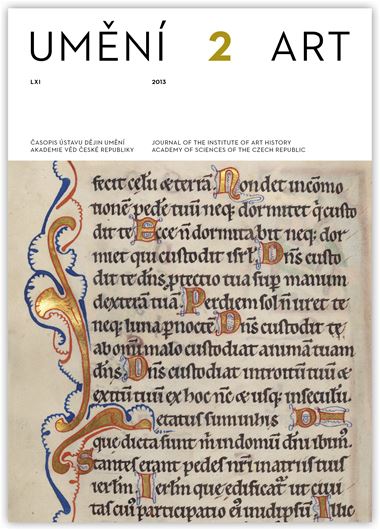Jiří Sobek
Ornamentika fleuronné v rukopisu Mater verborum
This article deals with the fleuronné ornament found in the etymological glossary Mater verborum in the Library of the National Museum in Prague (X A 11), examining it in the context of domestic and foreign manuscript illustrations from the middle of the 13th century. Fleuronné – ‘adorned with flowers’ – refers to an ornamental system based on plant forms, linearly drawn in several basic colours, usually blue, red, and black ink, and its basic elements comprise filaments, palmettos, semi-palmettos, buds, pearls, squares, seeds, and stems. The forerunners of this type of ornament were the so-called silhouette initials found in 12th-century manuscripts from northern and eastern France and southern England. The origin of this new system of embellishment generally can be seen in the gradual simplification of earlier elements that were used as decorative elements in traditional painted Romanesque and pre-Romanesque initials. In the Czech lands, an early basic type of fleuronné ornament appeared before the first quarter of the 13th century. Mater verborum, which dates from around 1240, is one of the earliest bound manuscripts in this country in which this type of ornamentation is found, but which still lacks the complex capillary patterns, so-called fadenwerk. The author believes that it is possible to distinguish approximately nineteen basic ornamental motifs in this literary gem, of which there are then multiple further variations. The prevailing forms are semi-palmettos, little buds, and acanthoids, often accompanied by capillaries. Besides these individual elements, it is also possible to identify by different criteria various groups of fleuronné initial which can be further divided into numerous subcategories. Decorative concepts employing this floral ornamentation are relatively heterogeneous in terms of quality and occurrence. In a qualitative perspective, the author is inclined to distinguish seven main groups of tertiary decor, and he also identifies seven artists who drew this type of initials, at least one of whom was a classic illustrator of illuminated manuscripts. One more illustrator can also be identified – the author of the rubrications, who was inspired by fleuronné ornament, but definitely did not directly contribute to the work of the seven creators mentioned. This manuscript fits logically within the context of domestic and foreign art of that time, many of its elements having been drawn from northern France, southern England, and southern Germany.
Full-text in the Digital Library of the Czech Academy of Sciences:
https://kramerius.lib.cas.cz/uuid/uuid:5c9828bf-2246-46ca-8b38-1c278a0a22c1
< back

